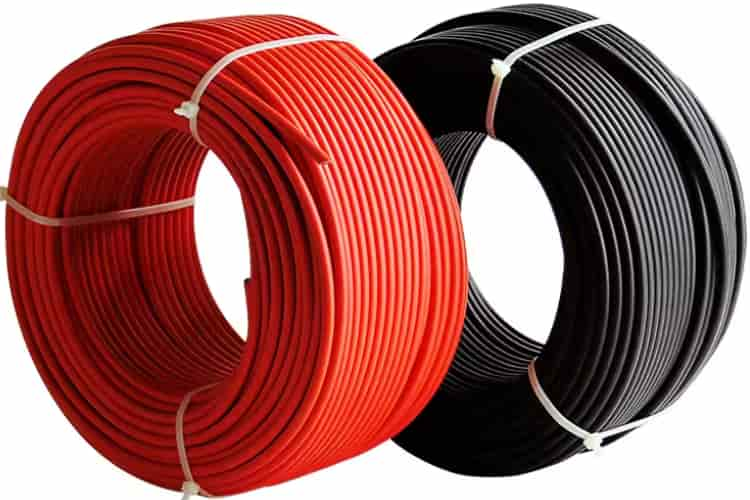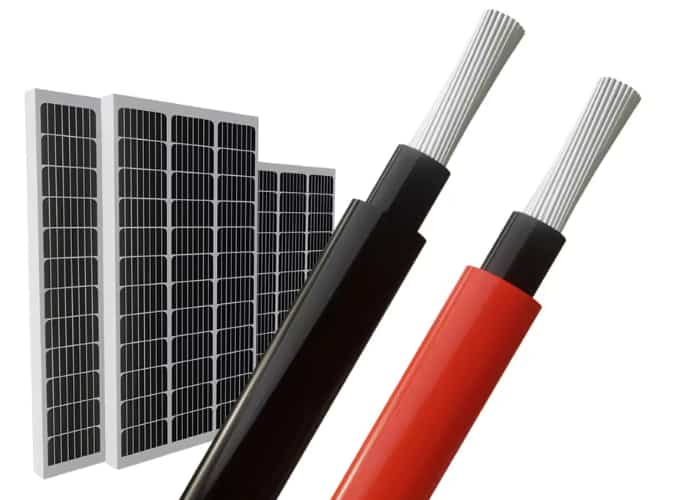1. 4mm Solar Cable Overview
4cabo solar mm, ou seja. cabo solar fotovoltaico com diâmetro nominal de núcleo de 4 milímetros quadrados, é um cabo especial projetado para sistema de geração de energia solar fotovoltaica. É usado principalmente para conectar painéis solares, inversores, controllers and other photovoltaic system components to ensure efficient and safe transmission of electrical energy. With excellent conductivity, resistência às intempéries, corrosion resistance and ease of installation, this cable is an important and indispensable part of the solar photovoltaic power generation system.

2. 4mm Solar Cable main characteristics
High-efficiency conductivity: 4mm solar cable usually adopts tinned copper stranded wire as conductor, this conductor material has excellent conductivity, which can ensure that the loss of current in the transmission process is reduced to a minimum, and improve the power generation efficiency of the photovoltaic system.
Weather resistance: the outer layer of the cable is made of special materials, such as cross-linked polyethylene (XLPE), low-smoke halogen-free polyolefin, etc.. These materials have excellent resistance to ultraviolet rays, aging, weathering, etc., and can operate stably for a long period of time in harsh outdoor environments, extending the service life of the cable.
Corrosion resistance: tinned copper stranded conductors not only have good electrical conductivity, but also have excellent corrosion resistance, able to resist the erosion of acids and alkalis and other corrosive substances, to ensure that the cable can work properly in humid, salt spray and other harsh environments.
Easy to install: 4mm solar cable is designed to be flexible, easy to bend and install, and can adapt to a variety of complex photovoltaic system layouts. Ao mesmo tempo, both ends of the cable usually adopt standardised connectors or terminals, which is convenient for users to quickly connect and debug.
Safety: The cables comply with relevant safety standards and norms, such as UL, CE, EM 50618 and other certifications, with excellent electrical and mechanical properties, can maintain stable operation under harsh working conditions such as high voltage and high current, ensuring the safety and reliability of the PV system.
3. 4mm Solar Cable application areas
4mm solar cable is widely used in various solar photovoltaic power generation systems, including but not limited to:
Rooftop photovoltaic systems: used to connect roof-mounted solar panels and inverters, controllers and other components.
Ground photovoltaic power station: in large ground photovoltaic power station, used to connect hundreds of solar panels composed of battery arrays and inverters, transformers and other equipment.
Portable solar power systems: such as solar chargers for camping, solar power for outdoor adventure, etc., 4mm solar cable is also an indispensable connecting component.
4. 4mm Solar Cable performance parameters
The performance parameters of 4mm solar cable include rated voltage, rated current, operating temperature range and so on.
Tensão nominal: usually determined according to the cable insulation materials and design standards, common rated voltage DC 1000V, AC 0.6/1kV, etc.. This indicates that the cable can work normally without breakdown or damage under the specified voltage.
Rated current: It is determined according to the cross-sectional area of the cable, the conductor material and the thickness of the insulation layer. For a 4mm solar cable, the current rating is usually between 33A and 57A, depending on the exact specification and type of cable.
Operating temperature range: Since solar cables are usually installed in outdoor environments, they need to have good temperature resistance. De um modo geral, the operating temperature range of 4mm solar cables can cover temperatures from -30°C to +100°C or even higher to ensure stable operation in all climatic conditions.

5. 4mm Solar Cable Advantages and application scenarios
4mm solar cables have the following advantages over other types of cables:
Efficient transmission: the use of highly conductive tinned copper stranded wire as the conductor ensures efficient transmission of electricity and reduces energy loss during transmission.
Strong weather resistance: the outer sheath material has good weather resistance, which can resist the erosion of ultraviolet rays, moisture and chemicals to extend the service life of the cable.
Safe and reliable: the cable meets the relevant safety standards and norms, has excellent electrical and mechanical properties, and is able to maintain stable operation under harsh working conditions such as high voltage and high current, ensuring the safety and reliability of the photovoltaic system.
4mm solar cables are widely used in various solar photovoltaic power generation systems, including but not limited to rooftop photovoltaic systems, ground-mounted photovoltaic power plants, portable solar power generation systems and so on. In these application scenarios, the cables are responsible for transmitting the power from the solar panels to the inverter for conversion, and then outputting the power to the grid or for use by local loads.
6. 4mm Solar Cable installation and wiring
Wiring Planning:
Detailed wiring planning is required before installing the 4mm solar cable. This includes determining the cable routing, comprimento, and location of connection points to ensure that the cable can efficiently transmit power and meet the overall layout requirements of the PV system.
Wiring should minimise cable bends and crossovers to reduce cable resistance and losses.
Installation requirements:
When installing the cables, the relevant electrical installation codes and standards should be followed to ensure that the fixing, connection and grounding of the cables are in accordance with safety requirements.
Special connectors or terminals should be used for the joints of the cables, and ensure that the connections are firm and reliable to prevent the occurrence of faults such as poor contact or short circuit.
During installation, the cables should be protected from mechanical damage or chemical corrosion, especially in the case of cables travelling through walls, on the ground or exposed to harsh environments, and the necessary protective measures should be taken.
7. Troubleshooting and handling of cables
Fault Troubleshooting:
When there is a power transmission fault in the PV system, the 4mm solar cable should first be checked for problems. Common cable faults include short circuit, broken circuit, poor contact, etc..
Electrical testing tools such as multimeters can be used to test the cable’s resistance, insulation resistance and other parameters to determine whether the cable is faulty.
You can also observe the appearance of the cable and the connections for breakage, aging or looseness, which may also be the cause of the fault.
Troubleshooting:
Once the cable is found to be faulty, it should be handled promptly. For short-circuited or broken cables, it is necessary to replace the damaged part or the whole cable.
For cable joints with poor contact, reconnect them and ensure that the connection is firm and reliable.
When dealing with cable faults, attention should be paid to the safe use of electricity and the prevention of electric shock accidents.
8. Environmental protection and sustainability of cables
Environmentally friendly materials:
Modern 4mm solar cables are often made from environmentally friendly materials, such as low-smoke, halogen-free insulation and recyclable sheathing materials. These materials have less impact on the environment during production and use and meet the requirements of sustainable development.
Long-term benefits:
While the initial investment in solar cables may be high, the long-term benefits are significant. As solar energy is a clean, renewable source of energy, the use of solar cables can help combat climate change and protect the environment by reducing dependence on fossil fuels and reducing greenhouse gas emissions.
9. 4mm Solar Cable Markets and future trends
Demanda de mercado:
With the global emphasis on renewable energy and the continuous development of solar energy technology, the market demand for 4mm solar cables is growing. Especially in countries and regions where the solar photovoltaic industry is developing rapidly, such as China, the United States, Europe, etc., the demand for high-quality, high-performance solar cables is particularly urgent.
Future trends:
No futuro, with the continuous progress of technology and further cost reduction, the performance of 4mm solar cable will continue to improve, and the price will be more affordable. Ao mesmo tempo, with the development of smart grid and distributed energy, the intelligent and networked requirements for solar cables will also continue to improve. Portanto, the future of solar cables will pay more attention to technological innovation and quality improvement to meet market demand and promote the sustainable development of the solar industry.
10. 4mm Solar Cable Maintenance
In order to ensure the long-term stable operation of the 4mm solar cable, regular maintenance and upkeep is required. The following are some suggested maintenance measures:
Regular Inspection: Regularly check the appearance of the cable and the connections for any damage, aging or looseness, so that problems can be detected and dealt with in time.
Cleaning and Maintenance: Regularly clean the dust and dirt on the surface of the cable, keep the cable clean and dry, and prevent moisture and chemicals from eroding the cable.
Avoid mechanical damage: In the process of installation and use, pay attention to avoid mechanical damage to the cable, such as extrusion, excessive bending, etc., so as not to affect the performance and service life of the cable.
